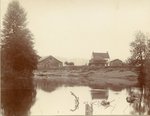
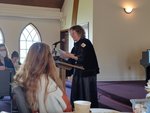
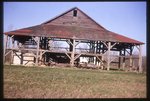
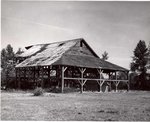
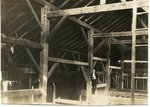
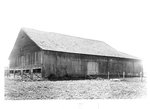
When she dons her long black dress and lacy cap, octogenarian Jean Bluhm of Chehalis adopts the persona of pioneer Mary Adeline (Roundtree) Borst, who crossed the Oregon Trail from Illinois in 1852.
But Mary didn’t live long with her parents, James Harrison and Emeline Cole (Riddle) Roundtree. On Oct. 15, 1854, when she was 16, she married Joseph Borst, a man twice her age who was born in 1822 in Schoharie County, New York. His parents, William and Nancy Ann (Bookout) Borst, eventually expanded their family to 15 children.
“And on the way west, they had children in Iowa, Wisconsin, Missouri, South Dakota,” Bluhm told several dozen women gathered in Centralia a week ago for the Centralia/Chehalis Christian Women’s Connection luncheon.
Joseph’s younger brother, Jeremiah, one of three brothers to follow the Gold Rush to California, was the first permanent white settler in the upper Snoqualmie Valley. His sister, Diane, settled at Duwamish near Seattle.
“Now I set my hat for Joseph when I saw him coming to my father’s lumberyard in Union,” Bluhm said.
After Joseph and Mary wed, the couple lived in a small cabin on Joseph’s 320-acre homestead on the south side of Fords Prairie, but he had promised to build his bride a beautiful big house near the banks of the Chehalis River. During Indian unrest in 1855-56, the young family sheltered for a year at Fort Henness, a log stockade near Grand Mound with blockhouses at the northwest and southwest corners.
“When we returned, they had built a blockhouse,” Bluhm said in her role as Mary. “Joseph bought it for $500 and we moved in.”
They had rented their cabin to another family. “I really liked it there for it smelled of cedar.” She gave birth to her daughter Ada in the blockhouse.
In 1860, Joseph built the stately white home with a balcony and green shutters on the Military Road that his wife had requested. He also constructed a massive barn of hand-hewn lumber — some more than a foot thick — and held the pieces together with wooden pegs. The sturdy barn was large enough to drive a team and wagon inside, turn it around, and drive it out again. Joseph proclaimed proudly that his home and barn would last for 80 years. In fact, the home still stands, and the barn survived a century before the Columbus Day storm of 1962 severely damaged it and city officials decided seven years later to demolish it.
Joseph seasoned the lumber from Tumwater for a year, ordered casings and hardware from San Francisco, and dipped the ends of every board in white lead to weatherproof it. He built a huge soapstone fireplace inside the house, which was nicely furnished and on the stagecoach route.
“Ulysses Grant (a young lieutenant at the time and later a U.S. president) and the governor, Isaac Stevens, both ate at my table,” Bluhm said in her role as Mary.
She also spoke about five of the Borst’s nine children who died young, buried in a little graveyard near the house.
Taking off her Mary Borst cap, Bluhm said, “I fell in love with the Borst family years and years ago and practically made it my own.”
Joseph died in 1885 at the age of 63, and Mary survived until Feb. 12, 1920, dying at 81.
In the early 1900s, the Borst homestead hosted the first airport in Lewis County, Bluhm said. After the Chehalis-Centralia Airport opened in 1928, having established an airstrip and Riverside Golf Course on part of the Donahoe farm a year earlier, the airport eventually closed. But the land hosted a car racetrack until 1965, Bluhm said, and also served as an equestrian center with stables for horses.
The City of Centralia paid $20,000 in 1921 for the Borst home and 15 acres, with the caveat that the family could live there.
In the 1930s, a grandson named Joseph Borst and his wife, Hazel, settled in the historic home, removed the enormous balcony, replacing it with a smaller one, and planted a peach orchard.
“They were very successful, and people came to the Borst home and bought peaches for years,” Bluhm said.
A large sign displayed on the side of the Borst barn, once the largest such structure in Washington Territory, touted “Peaches for Sale.”
She noted that in 1861, the coldest winter on record stretching from October to April, the Borsts and other pioneers lost many of their animals and trees.
“Joseph would go out and try to pull the cows up to their feet, and they just sit down and die,” Bluhm said. “He said I’m going to build up a barn, so we never have that happen again.”
In the 1950s, both the home and especially the massive barn were falling into disrepair. City officials floated the idea in 1955 of selling the land for a housing development but asked voters first whether to save the home and barn. They voted three to one in favor of saving the buildings, but nothing was done to repair them.
Then, on Oct. 12, 1962, a fierce storm with winds of 115 miles an hour or stronger slammed into the Pacific Northwest, uprooting trees, demolishing homes and barns, and killing more than four dozen Americans and Canadians. Although the house suffered only slight damage, winds ripped off one entire side of the Borst barn, exposing the horse-drawn hearse, a buggy or surrey, and other antiques stored inside to the elements. City officials used their insurance of $2,000, far short of the estimated $20,000 needed to restore the 101-year-old barn, to dismantle a portion as protection for anyone wandering beneath the heavy roof timbers.
A group called the Southwest Washington Pioneer Association launched a statewide effort to raise at least $3,000 initially to save the barn, and that’s when Bluhm, a retired schoolteacher, grew interested in the Borst family. One of her students lived in the home during the infamous storm.
“What is happening is a poor reflection on the community today,” a Dec. 29, 1962, Chronicle editorial decried. “Not only that, there will come a time when another generation will be unable to understand our poor judgment and lack of concern for a unique treasure.”
Unfortunately, the fundraising didn’t go well, and by Nov. 17, 1969, the city council voted to tear down the old barn.
Centralians gathered pieces of the lumber to use in homes and garages. Whenever Bluhm gives her presentation, she said, someone mentions using wood from the Borst barn as a mantle over the fireplace or for a carving.
“So the barn lives on,” Bluhm said, pointing a finger upward. “The city couldn’t save it, but God did.”
The double garage behind the house became a carriage house and hands-on museum for kids. The teachers of Lewis County decided to build a replica schoolhouse on the property in 1996. And in August, after five years of seeking money, recruiting volunteers, and shepherding the work, Bluhm oversaw the opening of a pioneer church on the Borst property along with a Victorian garden tended by master gardeners and an arboretum. A little graveyard shows the loss of Borst children, although their bodies were moved to Mountain View Cemetery.
“Right now I’m in the middle of writing four books,” Bluhm said: one on the Borst family tree, another on the Borst home and gardens, a third on those who lived in the home and volunteers who kept it open, and a fourth on the history of the buildings.
“Those pioneer people, men and women, they were so courageous and the children of this company that crossed the prairie, but we’re courageous too,” Bluhm said. “We live in a very unsettled time of our lives, and so in this we’re pioneers too. We have to step forward. We have to take our place, be strong, and do the best we can to keep this nation one nation under God forever.”
When Bluhm returned to her seat, I told her, “I want to be like you when I grow up.”
And, although the Borst barn didn’t survive, it’s in large part because of Bluhm and other volunteers like her that the community today sports unique treasures that portray a part of our pioneer history.
•••
Julie McDonald, a personal historian, may be reached at memoirs@chaptersoflife.com.